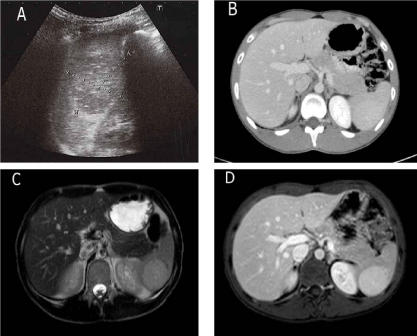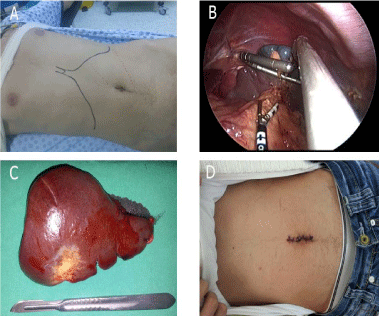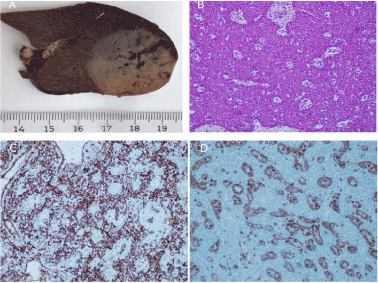Case Report
Splenic Hamartoma: Is Single-incision Laparoscopic Splenectomy Feasible?
Aktimur R1*, Kucuk OG2 Colak E2 and Alici O3
1Department of General Surgery, Istanbul Aydin University, Turkey
2Department of General Surgery, Samsun Research and Training Hospital, Turkey
3Department of Pathology, Gaziosmanpasa University, Turkey
*Corresponding author: Recep Aktimur, Department of General Surgery, Istanbul Aydin University, Istanbul, Turkey
Published: 10 Jun 2016
Cite this article as:Aktimur R, Kucuk OG, Colak E, Alici O.
Splenic Hamartoma: Is Single-incision
Laparoscopic Splenectomy Feasible?.
Clin Surg. 2016; 1: 1030.
Abstract
Introduction: ISplenic hamartoma is a very rare benign vascular proliferative neoplasm. To date more than 150 cases have been reported. Although hamartoma is benign and usually asymptomatic, it is important to distinguish it from malignant lesions, especially metastatic tumors. Surgical resection is required to confirm final pathologic diagnosis. Today, laparoscopic surgery is becoming the standart technique for both benign and malignant splenic disease and there is an increasing trend toward the application of single-incision surgery.
Case Description: A 24-year-old man with suggestive radiological features of a splenic hamartoma was admitted. Diagnosis of malignant tumor was not excluded completely, and intraumblical single-incision laparoscopic splenectomy was performed with conventional instruments and an energy device for hilar vessel control. The specimen was extracted intact through a relatively large intraumblical incision. The final pathological diagnosis was made as a splenic hamartoma.
Discussion: Although there are several radiological features giving clue in the diagnosis of splenic
hamartomas, our case showed slightly different radiological findings. In initial work-up, these cases
should be extensively evaluated and final diagnosis should be confirmed histopathologically. Singleincision
laparoscopic splenectomy using conventional instruments and vessel sealing device for
hilar management may be a safe and feasible procedure for the diagnosis and treatment of solid
splenic tumors, enclosing hamartoma. This is the first reported case of splenic hamartoma treated
with single incision laparoscopic splenectomy.
Keywords: Spleen; Hamartoma; Single incision; Splenectomy
Introduction
Splenic hamartoma is a very rare benign vascular proliferative neoplasm, which is composed of an anomalous mixture of normal splenic elements, such as red and white pulp [1]. To date more than 150 cases have been reported. Most cases were discovered incidentally while evaluating other medical problems or during autopsies. The estimated incidence is 0.024% - 0.13% in autopsy series [2]. Although hamartoma is benign and usually asymptomatic, it is important to distinguish it from malignant lesions especially metastatic tumors [3]. Advanced imaging techniques have led to an increase in the detection rate of incidental masses in the spleen. On the other hand, the diagnosis of a solitary splenic tumor may require splenectomy to assure a definitive histological diagnosis [4]. Laparoscopic surgery is becoming the standart technique for both benign and malignant splenic disease, including hamartoma. To date, there are a few reports on laparoscopic splenectomy for hamartoma. Single-incision laparoscopic splenectomy (SILS-Sp) is increasingly popular, but there are no published case on single-incision laparoscopic surgery for splenic hamartoma. In this case presentation, we describe the first case of splenic hamartoma treated with intraumblical singleincision laparoscopic splenectomy.
Case Presentation
A 24-year-old man was referred to our general surgery department for further evaluation of a
solitary solid splenic mass found incidentally during the assessment of a nonspecific abdominal pain.
His past medical history was uneventful. On physical examination, there was no palpable mass in the
abdomen. The laboratory work-up was totally normal. Abdominal ultrasonography (US) showed a
regular contoured hypoechoic solid mass in the lower pole of the spleen (Figure 1A). The mass was
homogeneous and slightly hyperdense on an enhanced abdominal
CT, after intravenous administration of contrast material (Figure 1B).
The abdominal MRI showed a 42 x 42 mm regularly contoured solid
mass in the posterior central aspect of the spleen. The mass has weak
hyperintensity in the axial T2-weighted image and has homogeneous
and intensive enhancement after intravenous gadolinium (Figure1C and d). This images is thought to be suggestive for diagnosis of a
splenic hamartoma. Although the diagnosis of malignant tumor was
not excluded completely, an intraumblical SILS-Sp was performed.
The patient was placed on the operating table in a right semilateral
decubitus position (Figure 2A). An intraumblical incision measuring
4 cm was made and a special port was used that is designed for a
single-incision laparoscopic surgery. The OCTOTMPort (Dalimsurg,
Seoul, Korea) contains a wound protector and removable plate
with four trocars: two 5 mm, one 10 mm and one 5-12 mm. With
the use of a curved laparoscopic retractor, conventional 10 mm –
30º laparoscope, hook with monopolar cautery, and 5-mm blunttip
LigaSureTM (Covidien, Norwalk, CT) vessel sealing device, the
spleen was resected and the specimen extracted intact through the
relatively large incision in a plastic bag (Figure 2B, 2C, and 2D). The
total operation time and estimated intraoperative blood loss were 60
minute and 20 mL respectively. The patient’s postoperative course
was uneventful and he was discharged on the second postoperative
day.
Figure 1
Figure 1
US, CT and MRI images of the patient. a) US image, b) Contrast
enhanced CT image, c-d) T2 weighted MRI images of the splenic hamartoma.
The resected specimen measured 12 x 9 x 6 cm, the mass was 4 x 3 x 3 cm in size and it was located subcapsular. Gross examination showed a well-circumscribed brown, solid mass with slit-like spaces (Figure 3A). Histopathologically, the mass showed expansive growth, compressing the surrounding splenic tissue with a regular margins. The tumor consisted of solid layers of cells lined by large eosinophilic cytoplasm and oval-round or spindle-shaped nuclei, with sinusoidlike spaces present in between (Figure 3B). Among these cells, there was a mononuclear type of inflammatory cells. Immunohistochemical staining was performed, and the layered cells were frequently positive for CD34, CD31 and factor VIII-related antigen (Figure 3C). The lining cells of the sinusoid-like spaces were CD8-positive (Figure 3D). The scattered stromal macrophages were CD68-positive. S-100 was negative. SMA was showed cytoplasmic and membranous stainings in focal areas. The final pathological diagnosis was made as a splenic hamartoma.
Figure 2
Figure 2
a) Patient positioning, b) Intraoperative image of curved
laparoscopic retractor and anterior approach to hilar vessel with the use
of LigaSure device, c) Resected specimen, d) Relatively large incision for
proper removal of specimen.
Discussion
Solid lesions of the spleen are rare and generally asymptomatic. Most cases are found incidentally. In initial presentation splenomegaly, palpable mass, spontaneous rupture, anemia, thrombocytopenia and abdominal pain may be seen. When a newly discovered splenic mass is seen in patients, benign or malign causes should be considered. Differential diagnosis includes metastatic and primary malignancies: non-Hodgkin’s lymphoma which is the most common lymphoid and angiosarcoma which is the most common nonlymphoid primary malignant tumor of the spleen should be considered [5]. Benign lesions of the spleen are extremely rare in autopsy series and most of them have vascular origin [6]. Therefore, when a splenic mass is discovered in a patient, excessive evaluation and exclusion of a malignant etiology is necessary. Imaging studies may provide valuable information about the nature of the lesion. Depend on it’s own histological characteristics, splenic hamartomas have some particular radiologic features [7]. In this case, radiologic features of the splenic hamartoma have some differs from previously described cases: US showed hypoechoic, CT showed hyperdense mass in the spleen. Therefore, the diagnosis of splenic hamartoma was not made upon these radiologic features, but MRI findings were clearly suggestive for a splenic hamartoma.
Preoperative tissue diagnosis would be the most beneficial diagnostic tool while making decision on a suspicious splenic mass. In the literature, fine-needle aspiration (FNA) of splenic lesion has been reported. Studies reporting FNA results were mostly conducted upon malignant disease with suspected splenic metastasis [8,9]. They were suggested low morbidity rate and no biopsy-site seeding of tumors with FNA biopsy. But incidentally discovered lesions have small portion in these studies. Also, patients who have malignant splenic mass underwent splenectomy for removal of malign tissue and characterizing histologic features. Therefore, FNA biopsy for a solitary splenic mass with no history of malignancy is not justified unless the patient cannot tolerate splenectomy. On the other hand, benign splenic masses commonly have vascular origin, and FNA biopsy may cause of troublesome bleeding. Thus, we have not performed a FNA biopsy for these reasons. Histological features of the tumor was obtained after the surgery. In this case, lining cells with sinusoid-like spaces typically positive for CD8, CD31, CD34 and factor VIII-related antigen [10].
Figure 3
Figure 3
a) Macroscopic appearance of the tumor, b)Solid layers of cells
lined by large eosinophilic cytoplasm and oval-round or spindle-shaped
nuclei, c)Layered cells were frequently positive for CD34, CD31 and factor
VIII, d)The lining cells of the sinusoid-like spaces were CD8-positive.
Today, laparoscopic splenectomy (LS) is the standart surgical procedure for the treatment of most benign and malignant splenic diseases. The advantages of LS includes less complications such as pnemonia and atelectasis, shorter hospital lenght of stay (LOS), less pain and earlier return to daily activity [11]. Spleen is a fragile organ and prone to hemorrhage when the capsule is violated. Therefore, it should be manipulated carefully and grasping should be avoided, especially for a suspicious solid mass. To defeat this manipulation challenge, hand-assisted laparoscopic splenectomy (HALS) was described with the advantage of palpation, retraction and easy control of hemorrhage. With the improvement of technique and instruments, totally laparoscopic and single incision laparoscopic splenectomy is increasingly being performed. SILS-Sp is a feasible and safe technique with improved cosmesis [12].
To the best of our knowledge, only five cases of LS for splenic hamartoma were reported previously, and there are no published case on intraumblical single-incision laparoscopic surgery for splenic hamartoma [13-17]. In our case, we performed SILS-Sp using conventional scope and instruments. Total operative time and blood loss were comparable to standart LS. In this case, another important technical point is the hilar vessel management. In a recent review, Fan et al. assessed the published literature on SILS-Sp between 2009 and 2012. In this review, there were no reported SILS-Sp performed with the help of vessel sealing device for hilar control [12].
Although there are several radiological features giving clue in the diagnosis of splenic hamartomas, our case showed slightly different US and CT findings and the diagnosis was made according to MRI. In initial work-up, these cases should be extensively evaluated and final diagnosis should be confirmed postoperatively. In conclusion, SILSSp using conventional instruments and vessel sealing device for hilar management may be a safe and feasible procedure for the diagnosis and treatment of solid splenic tumors, enclosing hamartoma.
References
- Silverman ML, LiVolsi VA. Splenic hamartoma. Am J Clin Pathol. 1978; 70: 224–229.
- Lam KY, Yip KH, Peh WC. Splenic vascular lesions: unusual features and a review of the literature. Aust N Z J Surg. 1999; 69: 422–425.
- Abbott RM, Levy AD, Aguilera NS, Gorospe L, Thompson WM. From the archives of the AFIP: primary vascular neoplasms of the spleen: radiologicpathologic correlation. Radiographics. 2011; 24: 1137–1163.
- Tessier DJ, Pierce RA, Brunt LM, Halpin VJ, Eagon JC, Frisella MM, et al. Laparoscopic splenectomy for splenic masses. Surg Endosc. 2008; 22: 2062–2066.
- Walsh RM, Heniford BT. Laparoscopic splenectomy for non-Hodgkin lymphoma. J Surg Oncol. 1999; 70: 116–121.
- Moriyama S, Inayoshi A, Kurano R. Inflammatory pseudotumor of the spleen: report of a case. Surg Today. 2000; 30: 942–946.
- M Wang JH, Ma XL, Ren FY, Zuo CJ, Tian JM, Wang ZF, et al. Multimodality imaging findings of splenic hamartoma: a report of nine cases and review of the literature. Abdom Imaging. 2013; 38: 154–162.
- Caraway NP, Fanning CV. Use of fine-needle aspiration biopsy in the evaluation of splenic lesions in a cancer center. Diagn Cytopathol. 1997; 16: 312–316.
- Keogan MT, Freed KS, Paulson EK, Nelson RC, Dodd LG. Imagingguided percutaneous biopsy of focal splenic lesions: update on safety and effectiveness. AJR Am J Roentgenol. 1999; 172: 933–937.
- Ali TZ, Beyer G, Taylor M, Volpe C, Papadimitriou JC. Splenic hamartoma: immunohistochemical and ultrastructural profile of two cases. Int J Surg Pathol. 2005; 13: 103–111.
- Bellows CF, Sweeney JF. Laparoscopic splenectomy: present status and future perspective. Expert Rev Med Devices. 2006; 3: 95–104.
- Fan Y, Wu SD, Kong J, Su Y, Tian Y, Yu H. Feasibility and safety of singleincision laparoscopic splenectomy: a systematic review. J Surg Res. 2014; 186: 354–362.
- Yoshizumi T, Iso Y, Yasunaga C, Kitano S, Sugimachi K. Laparoscopic splenectomy for splenic hamartoma. Surg Endosc. 1997; 11: 848–849.
- Tatekawa Y, Kanehiro H, Nakajima Y. Laparoscopic extirpation of splenic hamartoma. Pediatr Surg Int. 2007; 23: 911–914.
- Namikawa T, Kitagawa H, Iwabu J, Kobayashi M, Matsumoto M, Hanazaki K. Laparoscopic splenectomy for splenic hamartoma: Case management and clinical consequences. World J Gastrointest Surg. 2010; 2: 147–152.
- Pisani Ceretti A, Bislenghi G, Virdis M, Maroni N, Gatti A, Opocher E.Laparoscopic splenectomy for splenic hamartoma: a case report. Case Rep Gastrointest Med. 2012; 2012: 435802.
- Sim J, Ahn HI, Han H, Jun YJ, Rehman A, Jang SM, et al. Splenic hamartoma: A case report and review of the literature. World J Clin cases. 2013; 1: 217–219.



